Finishing a brick hearth is a rather delicate matter, requiring many details and nuances to be taken into account. It is necessary to cover the stove so that the coating is not only beautiful, but also lasts for more than one year.
Plastering oven
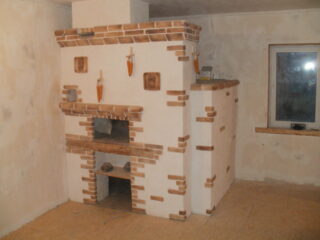
One of the most common and quickest ways to finish a brick oven is to plaster it.
Benefits:
- affordable cost;
- ease of implementation;
- the possibility of restoring old and refining new surfaces;
- applicability to any interior;
- an increase in the thickness and heat capacity of the walls;
- increasing the level of fire safety due to additional insulation.
Cons of coverage:
- increasing the heating time of the case;
- the need to choose a heat-resistant material;
- nondescript surface requiring additional decoration;
- the likelihood of cracking due to the difference in the coefficients of thermal expansion with the base.
You can decorate a brick stove with home-made solutions based on clay and sand or ready-to-use polymer compositions.
Tiling
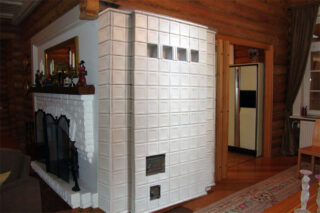
No less popular is the decision to glue the stove in a private house with tiles. Not every material is suitable for this, but the range of suitable materials is wide enough.
To veneer the brick surfaces of the hearth, you can use:
- Clinker. Consists of several types of clay, which, after pressing, is covered with glaze and pressed. The products are distinguished by high strength, thermal conductivity, and in appearance they resemble lacquered red bricks.
- Majolica. In the manufacture of ceramics is used, which in the molten state is embossed, followed by applying gloss and baking in an oven. The facing material has an excellent decorative component.
- Tiles. The design of the hearth with small volumetric figures gives a result that is stunning in beauty and efficiency. Fastening is carried out on metal staples and wire embedded in the masonry. It is expensive to decorate the stove body with tiles, but it is practical and durable. Such a structure will become a real decoration of the building.
- Tile. The decision to decorate the hearth with tiles is made with a limited budget, the coating is unstable to temperature changes and often falls off. Looks good and smart.
You can tile a brick stove in the house and without glue. For this, metal guides or point fasteners are used at the corners of the panels. The distance between the surfaces is minimized, as a result of which the heat transfer practically does not decrease, and the expansion of materials does not affect the integrity of the structure.
Furnace stone
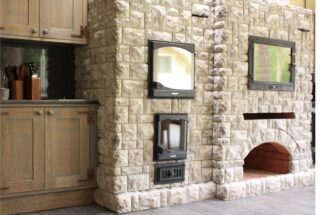
People started decorating hearths with stone thousands of years ago, this technology has not lost its relevance today. This type of cladding goes well with any interior style.
The options are:
- A natural stone. It is an environmentally friendly, durable, durable material with good heat retention and excellent high temperature resistance. The coating has a beautiful texture and natural range of colors. Depending on the priorities, sandstone and shell rock, granite and marble are selected.
- Talcochlorite. A unique mineral of the metamorphic type. Differs in presentability, high heat capacity, viscosity and strength.It is characterized by medicinal properties due to the release of vitamin "D" into the air. It is possible to cover the hearth with soapstone simultaneously with the removal of the furnace or at any time of its operation.
- Artificial turf. The materials are lightweight, affordable and not inferior to their natural counterparts in appearance. The decision to impose a stove in a wooden house is also justified by the fact that the structure is not overloaded while maintaining presentability. Clay, gypsum, polymer composite coatings are being prepared. If the owners are not satisfied with the color of the cladding, it can be painted in accordance with their tastes.
Having shown a creative approach and your masterful skills, it is quite possible to make a real work of art from an ordinary stove.
Cladding with metal sheets
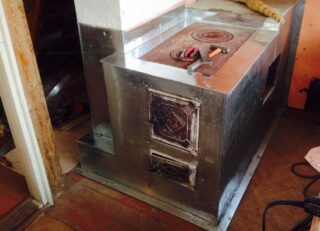
The decision to sheathe the stove with metal sheets is used not only for decoration purposes, but also as a way to reduce the consumption of masonry material. In the second case, a box is made, inside which the body is folded into a quarter of a stone. The gaps are filled with shungesite sand, which has a high heat capacity. This design heats up quickly and is practically immune to external factors. The work uses blued, galvanized steel, copper and aluminum.
Advantages of using metal:
- affordable cost;
- personable appearance;
- short terms of arrangement;
- ease of assembly;
- ease of cleaning and maintenance;
- the possibility of dismantling and improvement.
Cons of technology:
- the likelihood of overheating when the lining comes into contact with the door;
- susceptibility to corrosion by the creosote produced by the oven;
- inability to eliminate mechanical damage - dents, holes, deep scratches.
The stove can be finished completely or partially; the use of ribbed plates increases the heat transfer of the hearth.
To decorate the stove in the house in an interesting and unusual way, several types of material are often used. This approach is used not only for aesthetic, but also for purely practical purposes. You can decorate the basement and lounger with cheaper tiles, lay out the level of the firebox with tiles, and put a stone on top. There are many options, the main thing is to maintain harmony and follow the instructions for using the finish.
Adhesive materials
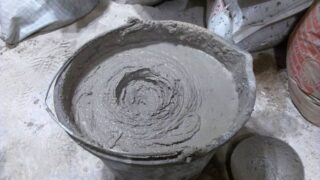
To prevent the facing coating from falling off in the first days of using the oven, you need to select an adhesive composition that meets the operating conditions of the device. You need to focus on criteria such as strong heating, thermal expansion, temperature difference, shrinkage of the structure.
List of possible formulations:
- Clay with polymer and natural fillers in the form of sand, sawdust, chaff. Depending on the fat content of the clay, 2.5-4 parts of additives are taken for 1 part of it.
- Cement with additives. The mortar has high strength and adhesion. The mixture is made of cement, clay, chalk and sand in a ratio of 1: 1: 1: 3.
- Ready mixes. The basis is refined quarry sand and chamotte kaolin clay. Polymer additives allow the adhesive to adapt to thermal expansion.
When choosing a material, you should give preference to proven products. It's better to overpay a little than to constantly redo the work.
Alternative finishing methods
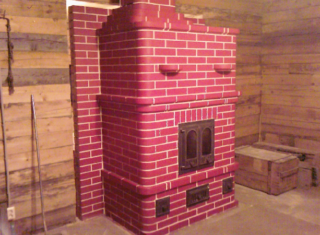
In the absence of money and funds, you can choose inexpensive but effective finishing methods.
The options are as follows:
- Coating with paint or varnish. Heat-resistant solutions are used that are resistant to temperature extremes.
- Slats upholstery. The lamellas are located on insulators 10-15 mm from the walls and at an interval of 3-5 cm. So the surface is masked, heat transfer is not disturbed.
In the past, the ovens were whitewashed with lime, but now this method is rarely used, since there are many more practical and effective options.








